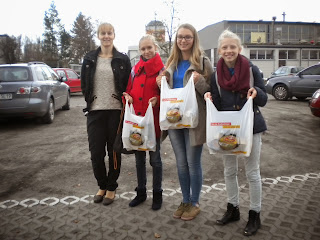BIGOS
INGREDIENTS:
1.5 kg sauerkraut
2 onions, finely chopped
2 tablespoons oil
1 piece of sausage usual, sliced
250 g boneless beef, diced
250 g veal, diced
100 g bacon, diced
150 ml red wine
3 tablespoons of tomato paste
1/2 handfuls of dried mushrooms
Half a handful of prunes
2 bay leaves
3 grains of allspice
1 tablespoon cumin
1 teaspoon marjoram
salt and pepper to taste
METHOD
Sauerkraut
rinse under running water if it is very acidic. Squeeze excess juice
, and then cut . Put into a large pot and pour boiling water , add
the plums , bay leaves and allspice . Simmer until just tender (about
50 minutes).
In the
meantime, pour boiling water over the dried mushrooms in a small pot
. Set aside .
Fry the
onion began to brag . Perfectly fried onions add the sausage and fry
brown.
In a
separate pot boil about a liter of water . To the boiling water add
the beef, veal and bacon. Cook for about 20 minutes , and then remove
the meat .
When
the cabbage is already soft, add the mushrooms ( drained and cut into
small pieces ), meat and onions with sausage. Simmer , uncovered, for
20 minutes. If there is too much water , it should be discarded.
Add red
wine and cook for another 15 minutes. Season with marjoram , caraway
seeds, salt and pepper. Add tomato puree and heat well .
Mrs R. Zdanowska, Siedlce, Poland






















.jpg)









